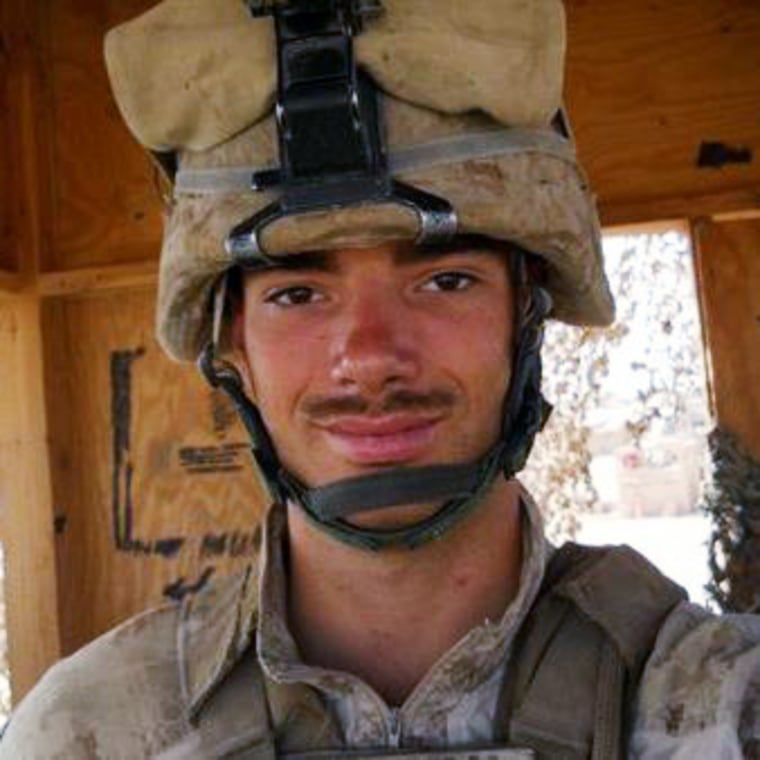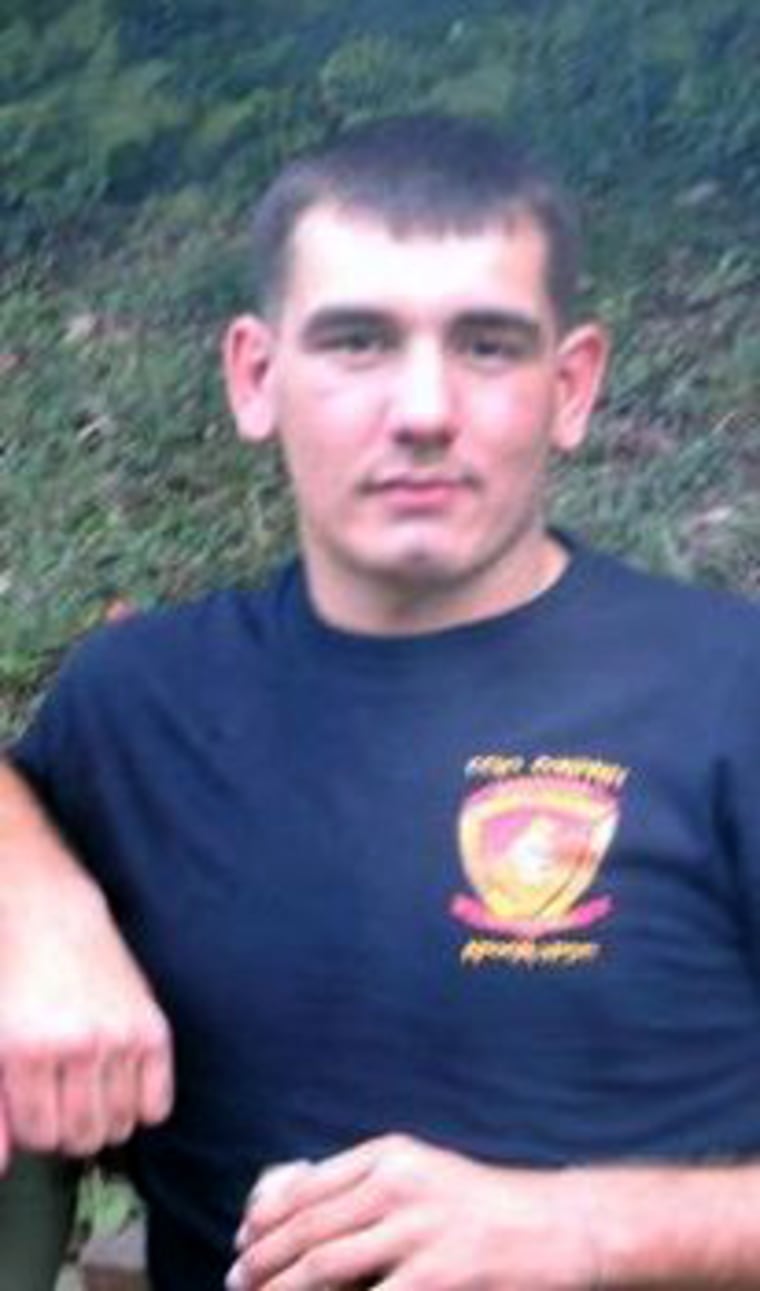It was pushing dusk when the call came: "One Category Alpha." The voice crackled over the radio, urgent but matter-of-fact. Translation: One man badly wounded, medical care needed right away.
The medical evacuation team — a pilot, co-pilot, crew chief, flight medic and, on this day, an AP photographer — scrambled into the Black Hawk helicopter. In a few minutes we were zigzagging at more than 150 mph, passing blurred fields and mud compounds like a movie in fast forward. The crew chief held up two fingers: Distance from landing zone, two minutes.
——————
As darkness fell, the Marines ignited a colored smoke grenade to mark the landing zone. The Black Hawk touched down only to be fired on by insurgents hiding nearby, despite the clear red cross marked on its nose and sides. It rose again and circled.
When it landed the second time, the crew chief threw open the side door to a storm of dust. Within seconds the Marines hauled aboard their comrade, who had a gunshot wound to the head.

The helicopter flew off, low and fast under fire. The medic went straight to work. But the wound was too severe.
The Marine died. Lance Cpl. Ross S. Carver of Rocky Point, N.C., was 21 years old.
——————
At least 1,310 U.S. soldiers and Marines have died since the Afghan war started, and at least 8,530 have been wounded. But the toll would be even higher if not for the medevac teams that swoop in to rescue the wounded and deliver them to relative safety.
Medevac teams work at about 20 locations in Afghanistan, where they serve as a net of sorts for soldiers and Marines caught in a high-wire act every day. The medics save everybody — U.S. soldiers and Marines, Afghan civilians, even Taliban fighters. The Helmand-based medevac team I traveled with — Charlie Company, from the 6th Battalion and 101st Aviation Regiment, known as Shadow Dustoff — is among the busiest in Afghanistan. Since the team arrived this spring, they have gone on more than 2,000 missions and have evacuated more than 2,500 patients.
In just five days, the team I was with picked up two Marines who died and five more who were wounded, as well as several wounded Afghan soldiers and civilians. The crews described it as a slow week.
The Army considers medevac crews to be among the most prone to post-traumatic stress because they see so much pain and carnage. Their job is dangerous: The medic and crew chief must often walk out to stunned or grieving soldiers over uncleared ground and take quick control. Crew members say it messes with their heads when soldiers are maimed.
"Sometimes we feel guilty. But it's just not your fault," says Staff Sgt. Audrey Ramos, 28, a flight medic with a Shadow Dustoff team. "You have to let it go. If you harbor it, if you carry it with you to the next mission, then you won't be able to give everything you need to give to the next soldier who has a chance to survive."
Ramos doesn't think about the politics of those she picks up — a life is a life. She says the job is the closest she can get to being on the front line: Injuries are intense, adrenaline runs high and soldiers look at you and the aircraft as a beacon of hope.
"I think that they see us as saviors," says Ramos. "It's humbling. I like to be a part of something bigger than me."
The vast majority of troops wounded in Afghanistan survive, thanks to the medevac teams. But that doesn't make it any easier to see somebody die.
When a soldier or Marine dies, it makes the war horribly real, very suddenly. As I was photographing the dying man half my age, I thought about all the things he would never see or do. I wondered about whether he had children back home. (Carver did, a son.)
But the words of soldiers and Marines I've patrolled on the ground with echoed through my head, always some variation of this: "The people back home don't have (any) idea what we're going through here. You can show them.
"You should've been here last week. My friend was blown up right in front of me."
——————
The day before, a bomb had exploded near a young Marine, Pfc. Justin Turner, 20, of Flower Mound, Texas.
Turner, who had been on a foot patrol, was scheduled to be promoted that day to lance corporal. The improvised explosive device, apparently detonated by remote control, spared his foot but left behind a shrapnel wound.
At first Turner didn't even know he was hit. His ears were ringing loudly, and there was a huge dust cloud. He tried to walk, but his foot felt as though it was broken.
That's when he noticed that his sock felt wet and blood was coming from his right boot. He was more angry than scared.
Staff Sgt. Richard Jarrett, a flight medic, ran to the wounded Marine, about 50 yards away from the landing zone. Arm in arm, Jarrett and Marine infantrymen helped Turner hobble toward the Black Hawk. The ground was rough, and one Marine tumbled into a deep irrigation ditch and became mired in mud.
As Jarrett checked and rewrapped Turner's bloodied-but-whole right foot, the two men joked and smiled at one another, yelling over the deafening roar of the airborne Black Hawk. Perhaps both were just relieved that Turner was one Marine who would be OK that day.
One more step, and he would have been killed by the blast.
"God was truly watching," Turner later said.
——————
It isn't always that way. On another rescue for Jarrett's crew the same day, the helicopter landed in a dusty haze to pick up two Marines said to be in potentially critical condition.
The first, shot in the chest, was carried unconscious to the helicopter by his comrades and gently laid on the floor.
Next came the other, shot twice in the arm. He walked aboard without help. The pilots took off full-throttle, accelerating and zigzagging — called “yanking and banking” — to evade enemy fire.
The Marine with the arm wounds had a tourniquet tightly applied and was sitting up, in pain but alert.
Jarrett focused on reviving the other man. He made an incision in the Marine's windpipe to put an oxygen tube through, in a complex tracheotomy. Wincing in pain, the other Marine used his able hand to help seal the tube.
But there wasn't enough lung tissue for the incoming air to reach, and the oxygen simply left again through the many holes made by the bullet.

Minutes later, we landed at a field hospital. The two patients were rushed into the trauma ward.
A short time later, the Marine with the chest wound — Lance Cpl. Joshua T. Twigg of Indiana, Pa. — was pronounced dead.
After a death — referred to as a KIA for Killed In Action, or often as an Angel — there is a marked silence among the crew, a sadness that hangs heavy. There are none of the usual jokes about how tight the landing zone was, or how deep the mud turned out to be, or where the ground fire was coming from. Medics often go away to be alone for a while, but there's never far to go since they must stay near the helicopter.
Crew members go through their routines, refuel, shut down their craft, examine it for battle damage and clean out the blood, used gauze, airway tubes, needles and other medical refuse, getting ready for the next emergency call.
It could come at any minute.
Staff photographer David Guttenfelder contributed to this report.